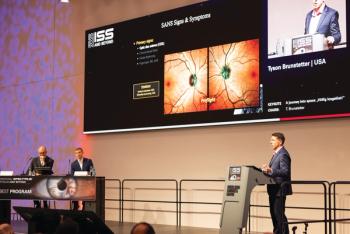
Towards a customised treatment of patients with keratoconic eyes
Tiago Monteiro, MD, discusses use of the latest design of intrastromal corneal ring segments, which increases options for customising treatment plans for patients with corneal ectatic disorders.
Numerous studies over the past decade have shown the implantation of
acuity and reducing the refractive error and mean
We have routinely treated keratoconus and other corneal ectatic disorders with ICRS implantation for over a decade now using different types of ICRS such as the
The main goals of the treatment are to correct the corneal ectasia, restore the regular prolate shape of the cornea, improve the associated refractive error and higher-order aberrations, and ultimately stop or at least delay the ectasia progression. More recently, we have started using the new asymmetric Keraring (AS) progressive thickness intrastromal ring segments, which are a welcome extension to the Keraring product line.
Properties and advantages
Similarly to the standard Keraring, the AS version is also made of polymethylmethacrylate (PMMA) with an ultraviolet blocker and a triangular prismatic cross section which is designed to mitigate visual disturbances in low light. It has a 5.0 or 6.0 mm optical zone. The key difference between the two models is in their thickness profiles; whereas the standard Kerarings have uniform thicknesses ranging from 150 μm to 350 μm in 50 μm steps, the Keraring AS presents a variable thickness within the same implant.
For the m160º arc the thickness variations currently available are 150/250 μm and 200/300 μm. Thus, it is thin at one end and gradually increases the thickness at the opposite end. For the 160º arc there are options of clockwise or counterclockwise direction of thickness increase while for the 330º arc there are available also 150/250 μm and 200/300 μm thickness variations model.
Also available is a model that is thinner at both tips and thicker at the centre of the arc segment.
The Keraring AS is indicated for the treatment of asymmetric keratoconus cases and produces a progressive flattening effect that allows for customisation of corneal remodelling according to the needs of each individual case.
The new AS segments represent a significant advance on current ICRS models. Major progress has been made in recent years in classifying keratoconus into several distinct categories based on the phenotype and morphological characteristics of the disease, thanks to the work and publications2 of Professor José Alfonso and his colleagues from the Instituto Oftalmologico Fernandez-Vega, Oviedo, Spain. Yet, although several distinct phenotypes of keratoconus have been identified, we could still only propose ICRS solutions that did not fully take account of the specific disease profile of each patient.
The Keraring AS overcomes that obstacle for treatment of asymmetric keratoconus and enables us to use different ICRS combinations in order to offer a truly customised solution to our patients. With over 40 variations of thickness, arc length, and diameter now available in entire range, we can effectively mix and match segments to correct the ectasia and tackle astigmatism and higher order aberrations such as coma in one simple procedure.
RELATED:
Other advantages include:
- the same indication and contraindication criteria as classic Keraring ICRS.
- there is no steep learning curve: the surgical technique is the same as for traditional ICRS using either manual methods or femtosecond laser to create the intrastromal pocket to implant the ring.
- enhanced customisation also results in better visual and refractive results for patients.
- the procedure is reversible and adjustable3 and can be combined, if necessary, with crosslinking to further stabilize the cornea.
Indications
Our main indications for Keraring implantation are keratoconus with reduced best-corrected visual acuity (BCVA) and contact lens intolerance, pellucid marginal degeneration, post-LASIK ectasia, and high mamounts of regular or irregular astigmatism after penetrating keratoplasty. The Keraring AS is ideal for cases of asymmetric keratoconus where the topographic flat axis is divergent from the coma axis by more than 30º.
In our experience, the ideal patient profile for ICRS implant is a young keratoconus patient with no extensive central corneal opacity or severe atopic disease who is not comfortable wearing rigid contact lenses and who desires a better visual acuity and enhanced quality of life.
Chair time is vitally important in order to properly educate patients about keratoconus and the objectives of the Keraring procedure so that they have realistic expectations.
Surgical technique
The surgical technique begins with construction of an intrastromal tunnel at a depth equivalent to 75% of the corneal thickness followed by implantation of the Keraring segments. Surgeons have the choice to either dissect the tunnel mechanically using special instrumentation or to use a femtosecond laser. We prefer the latter approach as it is more predictable and consistent than the mechanical technique and leads to better visual outcomes4. Once the ring segments have been implanted, a bandage contact lens is applied and left for two to three days and steroids and antibiotic eye drops are prescribed for one to two weeks postoperatively.
Surgical pearls
The most important pearl for this type of surgery starts with the preoperative assessment. It is vital to fully understand the morphologic classification of the disease. In the past, our ICRS selection and implantation nomograms were “blind” treatments based on axial topography and anterior curvature, with results measured simply in terms of corneal flattening following the rules of Barraquer
Nowadays, concepts such as quality of vision and aberrometry are part-and-parcel of the treatment process. The new nomograms for intracorneal segments are based on criteria such as subjective refraction, axial curvature, aberrometry (coma and other higher order aberrations), corneal asphericity and the location of the thinnest point of the cornea.
In keratoconus, there are three main vectors of astigmatism that need to be analysed in order to choose the correct implant: the topographic axis, the subjective astigmatism axis derived from the manifest refraction of the patient, and finally the coma aberration axis. Coma is the most important higher order aberration that has an impact on vision in keratoconus patients, so it is very important to correct this in order to obtain optimal visual outcomes.
We classify cases where the divergence between the flat topographic axis and the coma axis is more than 30º as non-coincident.
For such patients, the Keraring AS is the perfect solution to correct both axes effectively at the same time.
This is why proper classification of the keratoconus phenotype is so important as it allows us to match the correct ring segment to the type and severity of the ectasia.
The bottom line is that if the surgeon can understand and interpret the relationship between the various axes-topographic, refractive and aberrometric-then they will develop better nomograms and deliver better results for their patients.
The manufacturer also proposes a nomogram based on the Alfonso morphological classification of keratoconus which may be accessed via www.keraring.online.
Another important tip is to treat any ocular surface disease-allergic conjunctivitis and dry eye are frequently found in keratoconus patients. This applies irrespective of whether the surgeon plans to use rigid contact lenses, ICRS, corneal crosslinking, or a combination of these to treat the keratoconus.
We also stress to the patient the importance of avoiding eye rubbing as there is growing evidence that it is associated with progression of the disease.
Conclusion
Our initial experience suggests that Keraring AS has an effective remodelling effect on the cornea and delivers excellent refractive outcomes in eyes with asymmetric keratoconus. We have already started gathering data and, on an initial subset of 15 patients implanted with the ring segments, the refractive and anatomical outcomes were excellent.
Further prospective, long-term studies are needed to confirm the safety of the ring segments in these young patients. This latest design increases our options for customizing our treatment plans for patients with corneal ectatic disorders.
Disclosures:
Tiago Monteiro, MD, FEBO, FEBOS-CR
Dr Monteiro is an ophthalmologist in the Department of Ophthalmology, Hospital de Braga, Braga, Portugal. He has no financial interest in the products or companies mentioned.
References:
1. N. T. Giacomin, G. R. Mello, C. S. Medeiros et al., “Intracorneal ring segments implantation for corneal ectasia,” Journal of Refractive Surgery, vol. 32, pp. 829–839, 2016.
2. L. Torquetti, G. Ferrara, F. Almeida et al., “Intrastromal corneal ring segments implantation in patients with keratoconus: 10-year follow-up,” Journal of Refractive
Surgery, vol. 30, pp. 22–26, 2014.
3. Alfonso, J. et al, “Biomecánica y arquitectura corneal: MonografÃas SECOIR”, pp 180-184, 2014.
4. Monteiro T, Mendes JF, Faria-Correia F, Franqueira N, Madrid-Costa D, Alfonso JF. Adjustment of Intrastromal Corneal Ring Segments After Unsuccessful Implantation in Keratoconic Eyes. Cornea. 2017.
5. Monteiro T, Alfonso JF, Franqueira N, Faria-Correia F, Ambrosio R, Jr., Madrid-Costa D. Predictability of Tunnel Depth for Intrastromal Corneal Ring Segments Implantation Between Manual and Femtosecond Laser Techniques. Journal of refractive surgery. 2018;34(3):188-94.
Newsletter
Get the essential updates shaping the future of pharma manufacturing and compliance—subscribe today to Pharmaceutical Technology and never miss a breakthrough.







































